Neurological Case study 2022
VerifiedAdded on 2022/05/17
|5
|1436
|25
AI Summary
Contribute Materials
Your contribution can guide someone’s learning journey. Share your
documents today.
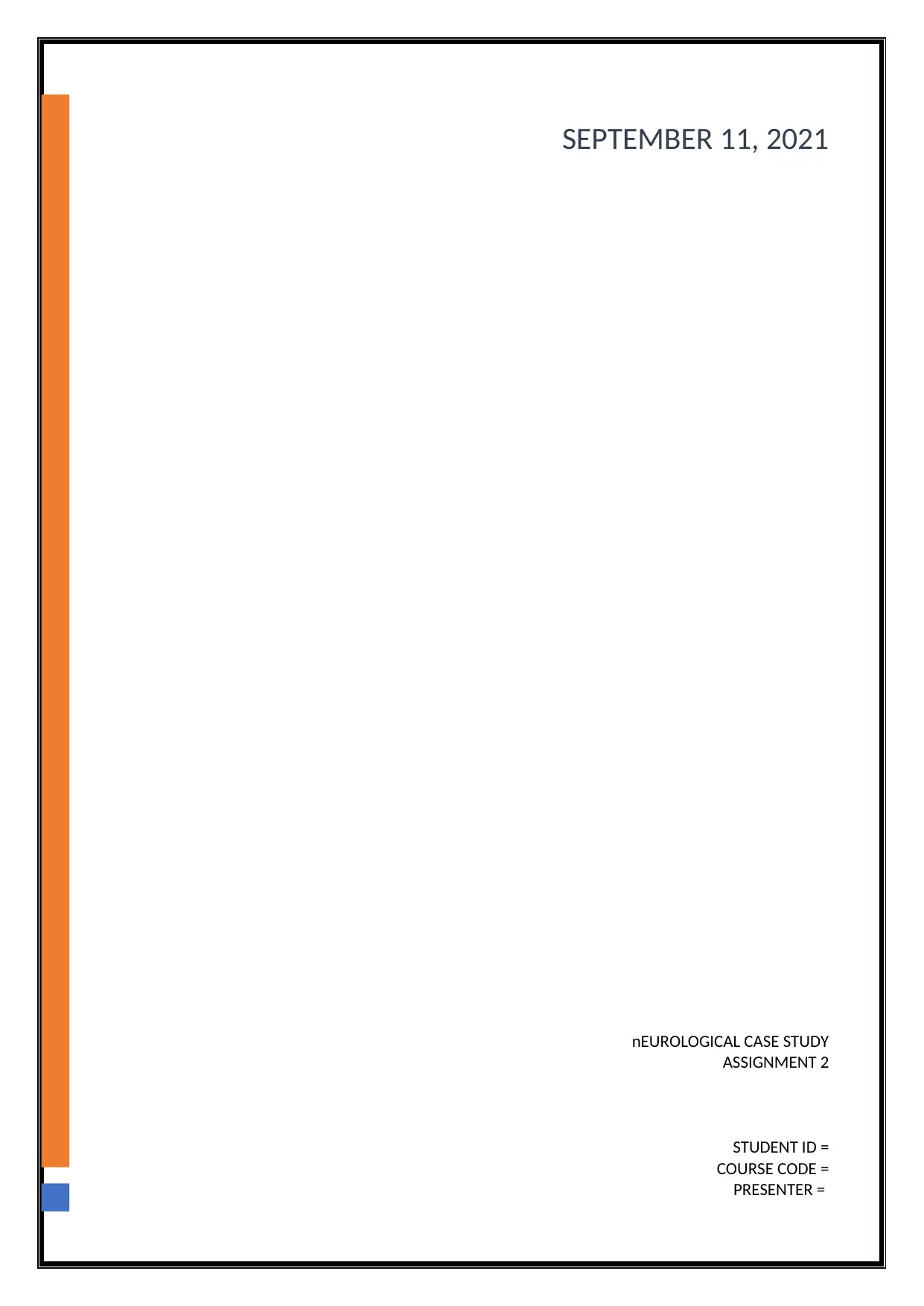
nEUROLOGICAL CASE STUDY
ASSIGNMENT 2
STUDENT ID =
COURSE CODE =
PRESENTER =
SEPTEMBER 11, 2021
ASSIGNMENT 2
STUDENT ID =
COURSE CODE =
PRESENTER =
SEPTEMBER 11, 2021
Secure Best Marks with AI Grader
Need help grading? Try our AI Grader for instant feedback on your assignments.
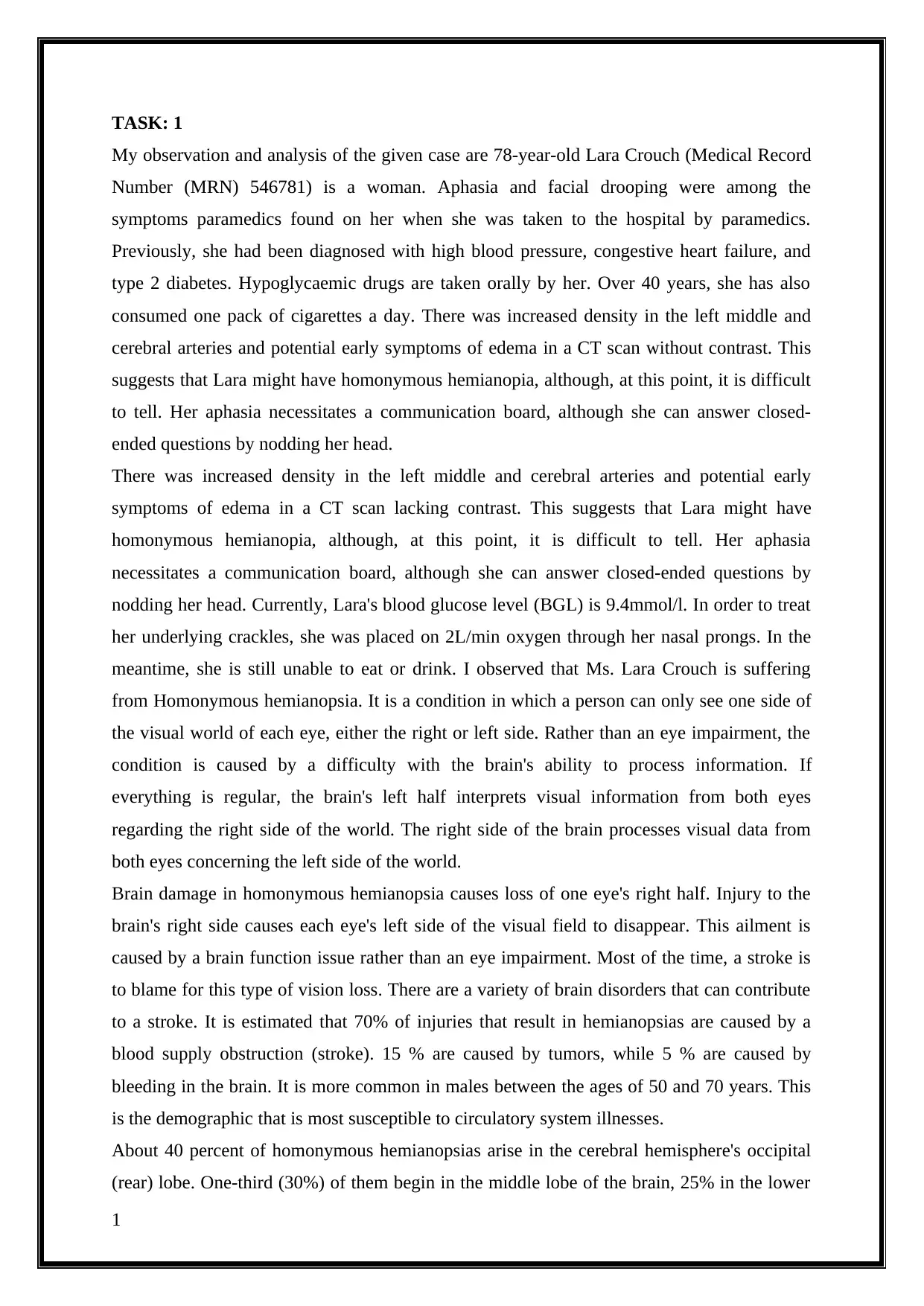
TASK: 1
My observation and analysis of the given case are 78-year-old Lara Crouch (Medical Record
Number (MRN) 546781) is a woman. Aphasia and facial drooping were among the
symptoms paramedics found on her when she was taken to the hospital by paramedics.
Previously, she had been diagnosed with high blood pressure, congestive heart failure, and
type 2 diabetes. Hypoglycaemic drugs are taken orally by her. Over 40 years, she has also
consumed one pack of cigarettes a day. There was increased density in the left middle and
cerebral arteries and potential early symptoms of edema in a CT scan without contrast. This
suggests that Lara might have homonymous hemianopia, although, at this point, it is difficult
to tell. Her aphasia necessitates a communication board, although she can answer closed-
ended questions by nodding her head.
There was increased density in the left middle and cerebral arteries and potential early
symptoms of edema in a CT scan lacking contrast. This suggests that Lara might have
homonymous hemianopia, although, at this point, it is difficult to tell. Her aphasia
necessitates a communication board, although she can answer closed-ended questions by
nodding her head. Currently, Lara's blood glucose level (BGL) is 9.4mmol/l. In order to treat
her underlying crackles, she was placed on 2L/min oxygen through her nasal prongs. In the
meantime, she is still unable to eat or drink. I observed that Ms. Lara Crouch is suffering
from Homonymous hemianopsia. It is a condition in which a person can only see one side of
the visual world of each eye, either the right or left side. Rather than an eye impairment, the
condition is caused by a difficulty with the brain's ability to process information. If
everything is regular, the brain's left half interprets visual information from both eyes
regarding the right side of the world. The right side of the brain processes visual data from
both eyes concerning the left side of the world.
Brain damage in homonymous hemianopsia causes loss of one eye's right half. Injury to the
brain's right side causes each eye's left side of the visual field to disappear. This ailment is
caused by a brain function issue rather than an eye impairment. Most of the time, a stroke is
to blame for this type of vision loss. There are a variety of brain disorders that can contribute
to a stroke. It is estimated that 70% of injuries that result in hemianopsias are caused by a
blood supply obstruction (stroke). 15 % are caused by tumors, while 5 % are caused by
bleeding in the brain. It is more common in males between the ages of 50 and 70 years. This
is the demographic that is most susceptible to circulatory system illnesses.
About 40 percent of homonymous hemianopsias arise in the cerebral hemisphere's occipital
(rear) lobe. One-third (30%) of them begin in the middle lobe of the brain, 25% in the lower
1
My observation and analysis of the given case are 78-year-old Lara Crouch (Medical Record
Number (MRN) 546781) is a woman. Aphasia and facial drooping were among the
symptoms paramedics found on her when she was taken to the hospital by paramedics.
Previously, she had been diagnosed with high blood pressure, congestive heart failure, and
type 2 diabetes. Hypoglycaemic drugs are taken orally by her. Over 40 years, she has also
consumed one pack of cigarettes a day. There was increased density in the left middle and
cerebral arteries and potential early symptoms of edema in a CT scan without contrast. This
suggests that Lara might have homonymous hemianopia, although, at this point, it is difficult
to tell. Her aphasia necessitates a communication board, although she can answer closed-
ended questions by nodding her head.
There was increased density in the left middle and cerebral arteries and potential early
symptoms of edema in a CT scan lacking contrast. This suggests that Lara might have
homonymous hemianopia, although, at this point, it is difficult to tell. Her aphasia
necessitates a communication board, although she can answer closed-ended questions by
nodding her head. Currently, Lara's blood glucose level (BGL) is 9.4mmol/l. In order to treat
her underlying crackles, she was placed on 2L/min oxygen through her nasal prongs. In the
meantime, she is still unable to eat or drink. I observed that Ms. Lara Crouch is suffering
from Homonymous hemianopsia. It is a condition in which a person can only see one side of
the visual world of each eye, either the right or left side. Rather than an eye impairment, the
condition is caused by a difficulty with the brain's ability to process information. If
everything is regular, the brain's left half interprets visual information from both eyes
regarding the right side of the world. The right side of the brain processes visual data from
both eyes concerning the left side of the world.
Brain damage in homonymous hemianopsia causes loss of one eye's right half. Injury to the
brain's right side causes each eye's left side of the visual field to disappear. This ailment is
caused by a brain function issue rather than an eye impairment. Most of the time, a stroke is
to blame for this type of vision loss. There are a variety of brain disorders that can contribute
to a stroke. It is estimated that 70% of injuries that result in hemianopsias are caused by a
blood supply obstruction (stroke). 15 % are caused by tumors, while 5 % are caused by
bleeding in the brain. It is more common in males between the ages of 50 and 70 years. This
is the demographic that is most susceptible to circulatory system illnesses.
About 40 percent of homonymous hemianopsias arise in the cerebral hemisphere's occipital
(rear) lobe. One-third (30%) of them begin in the middle lobe of the brain, 25% in the lower
1
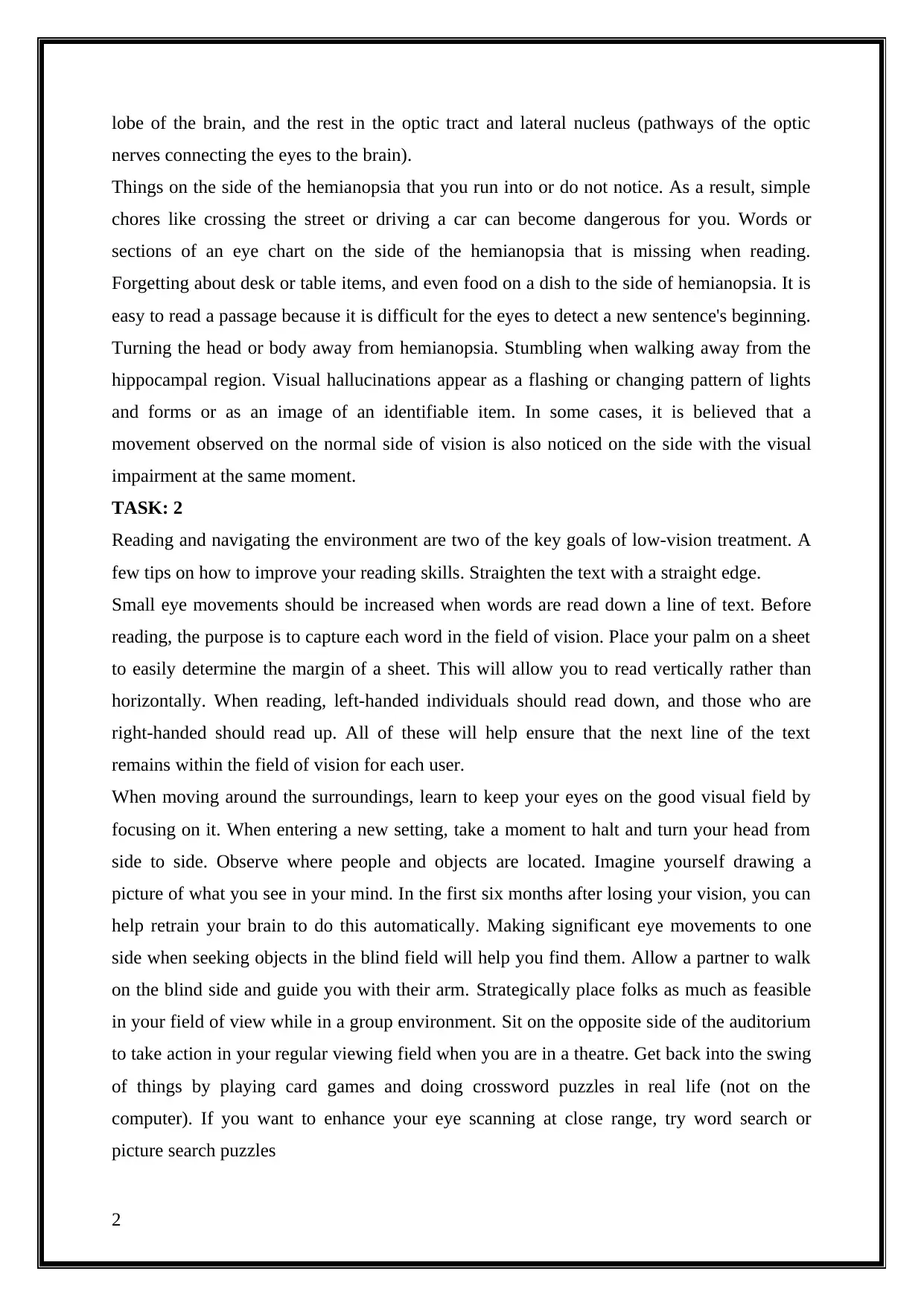
lobe of the brain, and the rest in the optic tract and lateral nucleus (pathways of the optic
nerves connecting the eyes to the brain).
Things on the side of the hemianopsia that you run into or do not notice. As a result, simple
chores like crossing the street or driving a car can become dangerous for you. Words or
sections of an eye chart on the side of the hemianopsia that is missing when reading.
Forgetting about desk or table items, and even food on a dish to the side of hemianopsia. It is
easy to read a passage because it is difficult for the eyes to detect a new sentence's beginning.
Turning the head or body away from hemianopsia. Stumbling when walking away from the
hippocampal region. Visual hallucinations appear as a flashing or changing pattern of lights
and forms or as an image of an identifiable item. In some cases, it is believed that a
movement observed on the normal side of vision is also noticed on the side with the visual
impairment at the same moment.
TASK: 2
Reading and navigating the environment are two of the key goals of low-vision treatment. A
few tips on how to improve your reading skills. Straighten the text with a straight edge.
Small eye movements should be increased when words are read down a line of text. Before
reading, the purpose is to capture each word in the field of vision. Place your palm on a sheet
to easily determine the margin of a sheet. This will allow you to read vertically rather than
horizontally. When reading, left-handed individuals should read down, and those who are
right-handed should read up. All of these will help ensure that the next line of the text
remains within the field of vision for each user.
When moving around the surroundings, learn to keep your eyes on the good visual field by
focusing on it. When entering a new setting, take a moment to halt and turn your head from
side to side. Observe where people and objects are located. Imagine yourself drawing a
picture of what you see in your mind. In the first six months after losing your vision, you can
help retrain your brain to do this automatically. Making significant eye movements to one
side when seeking objects in the blind field will help you find them. Allow a partner to walk
on the blind side and guide you with their arm. Strategically place folks as much as feasible
in your field of view while in a group environment. Sit on the opposite side of the auditorium
to take action in your regular viewing field when you are in a theatre. Get back into the swing
of things by playing card games and doing crossword puzzles in real life (not on the
computer). If you want to enhance your eye scanning at close range, try word search or
picture search puzzles
2
nerves connecting the eyes to the brain).
Things on the side of the hemianopsia that you run into or do not notice. As a result, simple
chores like crossing the street or driving a car can become dangerous for you. Words or
sections of an eye chart on the side of the hemianopsia that is missing when reading.
Forgetting about desk or table items, and even food on a dish to the side of hemianopsia. It is
easy to read a passage because it is difficult for the eyes to detect a new sentence's beginning.
Turning the head or body away from hemianopsia. Stumbling when walking away from the
hippocampal region. Visual hallucinations appear as a flashing or changing pattern of lights
and forms or as an image of an identifiable item. In some cases, it is believed that a
movement observed on the normal side of vision is also noticed on the side with the visual
impairment at the same moment.
TASK: 2
Reading and navigating the environment are two of the key goals of low-vision treatment. A
few tips on how to improve your reading skills. Straighten the text with a straight edge.
Small eye movements should be increased when words are read down a line of text. Before
reading, the purpose is to capture each word in the field of vision. Place your palm on a sheet
to easily determine the margin of a sheet. This will allow you to read vertically rather than
horizontally. When reading, left-handed individuals should read down, and those who are
right-handed should read up. All of these will help ensure that the next line of the text
remains within the field of vision for each user.
When moving around the surroundings, learn to keep your eyes on the good visual field by
focusing on it. When entering a new setting, take a moment to halt and turn your head from
side to side. Observe where people and objects are located. Imagine yourself drawing a
picture of what you see in your mind. In the first six months after losing your vision, you can
help retrain your brain to do this automatically. Making significant eye movements to one
side when seeking objects in the blind field will help you find them. Allow a partner to walk
on the blind side and guide you with their arm. Strategically place folks as much as feasible
in your field of view while in a group environment. Sit on the opposite side of the auditorium
to take action in your regular viewing field when you are in a theatre. Get back into the swing
of things by playing card games and doing crossword puzzles in real life (not on the
computer). If you want to enhance your eye scanning at close range, try word search or
picture search puzzles
2
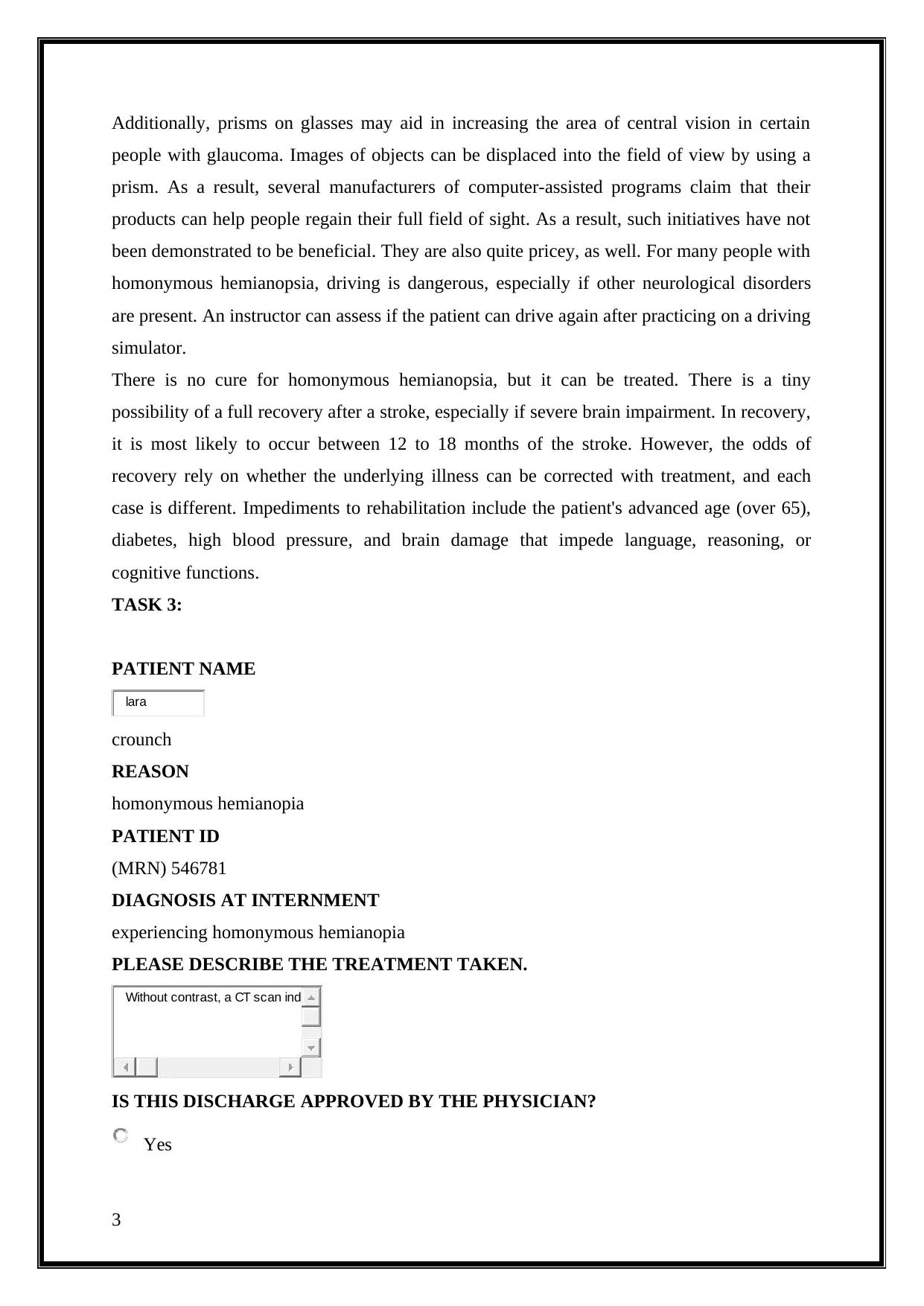
Additionally, prisms on glasses may aid in increasing the area of central vision in certain
people with glaucoma. Images of objects can be displaced into the field of view by using a
prism. As a result, several manufacturers of computer-assisted programs claim that their
products can help people regain their full field of sight. As a result, such initiatives have not
been demonstrated to be beneficial. They are also quite pricey, as well. For many people with
homonymous hemianopsia, driving is dangerous, especially if other neurological disorders
are present. An instructor can assess if the patient can drive again after practicing on a driving
simulator.
There is no cure for homonymous hemianopsia, but it can be treated. There is a tiny
possibility of a full recovery after a stroke, especially if severe brain impairment. In recovery,
it is most likely to occur between 12 to 18 months of the stroke. However, the odds of
recovery rely on whether the underlying illness can be corrected with treatment, and each
case is different. Impediments to rehabilitation include the patient's advanced age (over 65),
diabetes, high blood pressure, and brain damage that impede language, reasoning, or
cognitive functions.
TASK 3:
PATIENT NAME
crounch
REASON
homonymous hemianopia
PATIENT ID
(MRN) 546781
DIAGNOSIS AT INTERNMENT
experiencing homonymous hemianopia
PLEASE DESCRIBE THE TREATMENT TAKEN.
IS THIS DISCHARGE APPROVED BY THE PHYSICIAN?
Yes
3
lara
Without contrast, a CT scan ind
people with glaucoma. Images of objects can be displaced into the field of view by using a
prism. As a result, several manufacturers of computer-assisted programs claim that their
products can help people regain their full field of sight. As a result, such initiatives have not
been demonstrated to be beneficial. They are also quite pricey, as well. For many people with
homonymous hemianopsia, driving is dangerous, especially if other neurological disorders
are present. An instructor can assess if the patient can drive again after practicing on a driving
simulator.
There is no cure for homonymous hemianopsia, but it can be treated. There is a tiny
possibility of a full recovery after a stroke, especially if severe brain impairment. In recovery,
it is most likely to occur between 12 to 18 months of the stroke. However, the odds of
recovery rely on whether the underlying illness can be corrected with treatment, and each
case is different. Impediments to rehabilitation include the patient's advanced age (over 65),
diabetes, high blood pressure, and brain damage that impede language, reasoning, or
cognitive functions.
TASK 3:
PATIENT NAME
crounch
REASON
homonymous hemianopia
PATIENT ID
(MRN) 546781
DIAGNOSIS AT INTERNMENT
experiencing homonymous hemianopia
PLEASE DESCRIBE THE TREATMENT TAKEN.
IS THIS DISCHARGE APPROVED BY THE PHYSICIAN?
Yes
3
lara
Without contrast, a CT scan ind
Secure Best Marks with AI Grader
Need help grading? Try our AI Grader for instant feedback on your assignments.
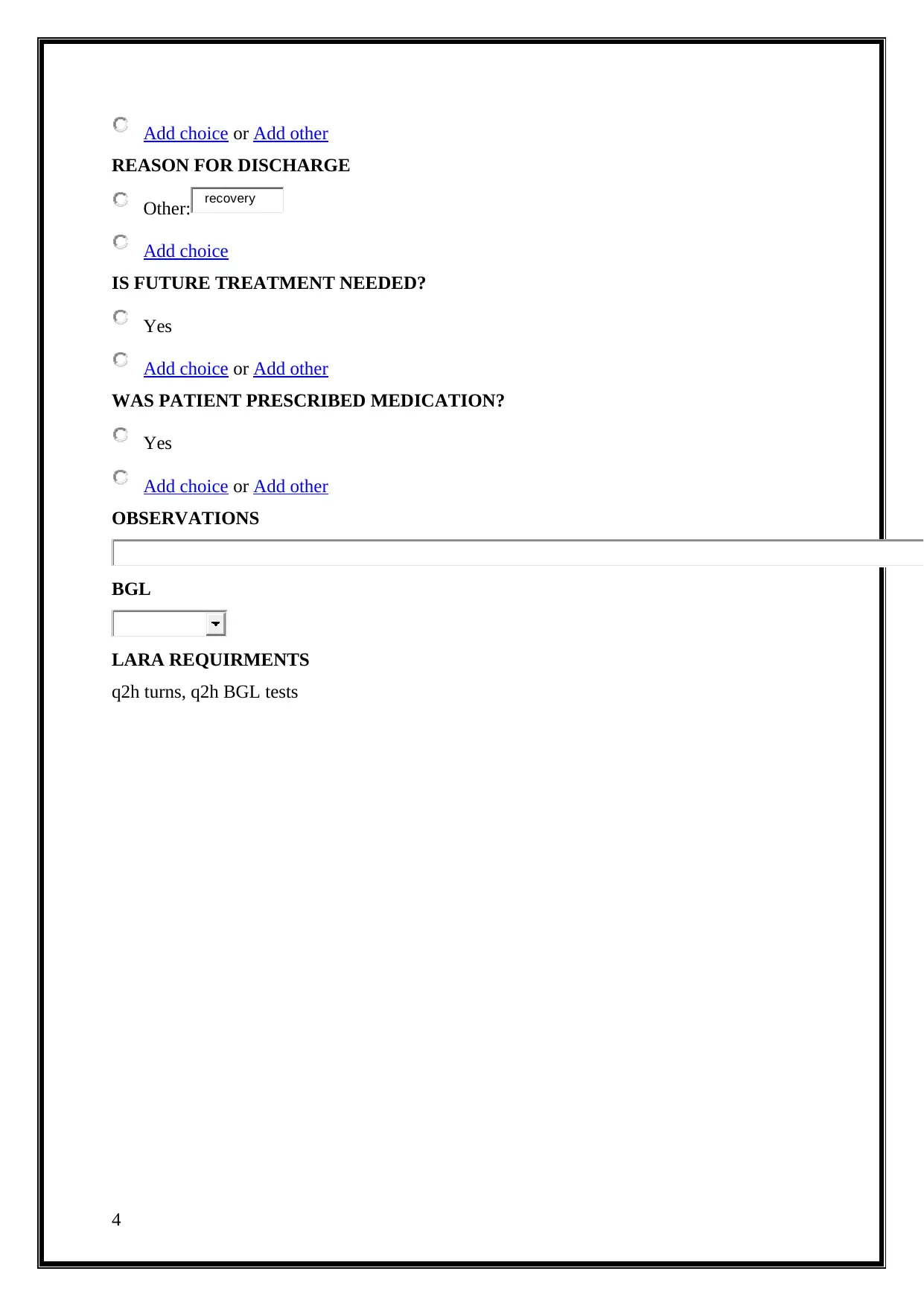
Add choice or Add other
REASON FOR DISCHARGE
Other:
Add choice
IS FUTURE TREATMENT NEEDED?
Yes
Add choice or Add other
WAS PATIENT PRESCRIBED MEDICATION?
Yes
Add choice or Add other
OBSERVATIONS
BGL
LARA REQUIRMENTS
q2h turns, q2h BGL tests
4
recovery
REASON FOR DISCHARGE
Other:
Add choice
IS FUTURE TREATMENT NEEDED?
Yes
Add choice or Add other
WAS PATIENT PRESCRIBED MEDICATION?
Yes
Add choice or Add other
OBSERVATIONS
BGL
LARA REQUIRMENTS
q2h turns, q2h BGL tests
4
recovery
1 out of 5
Related Documents
Your All-in-One AI-Powered Toolkit for Academic Success.
+13062052269
info@desklib.com
Available 24*7 on WhatsApp / Email
![[object Object]](/_next/static/media/star-bottom.7253800d.svg)
Unlock your academic potential
© 2024 | Zucol Services PVT LTD | All rights reserved.





